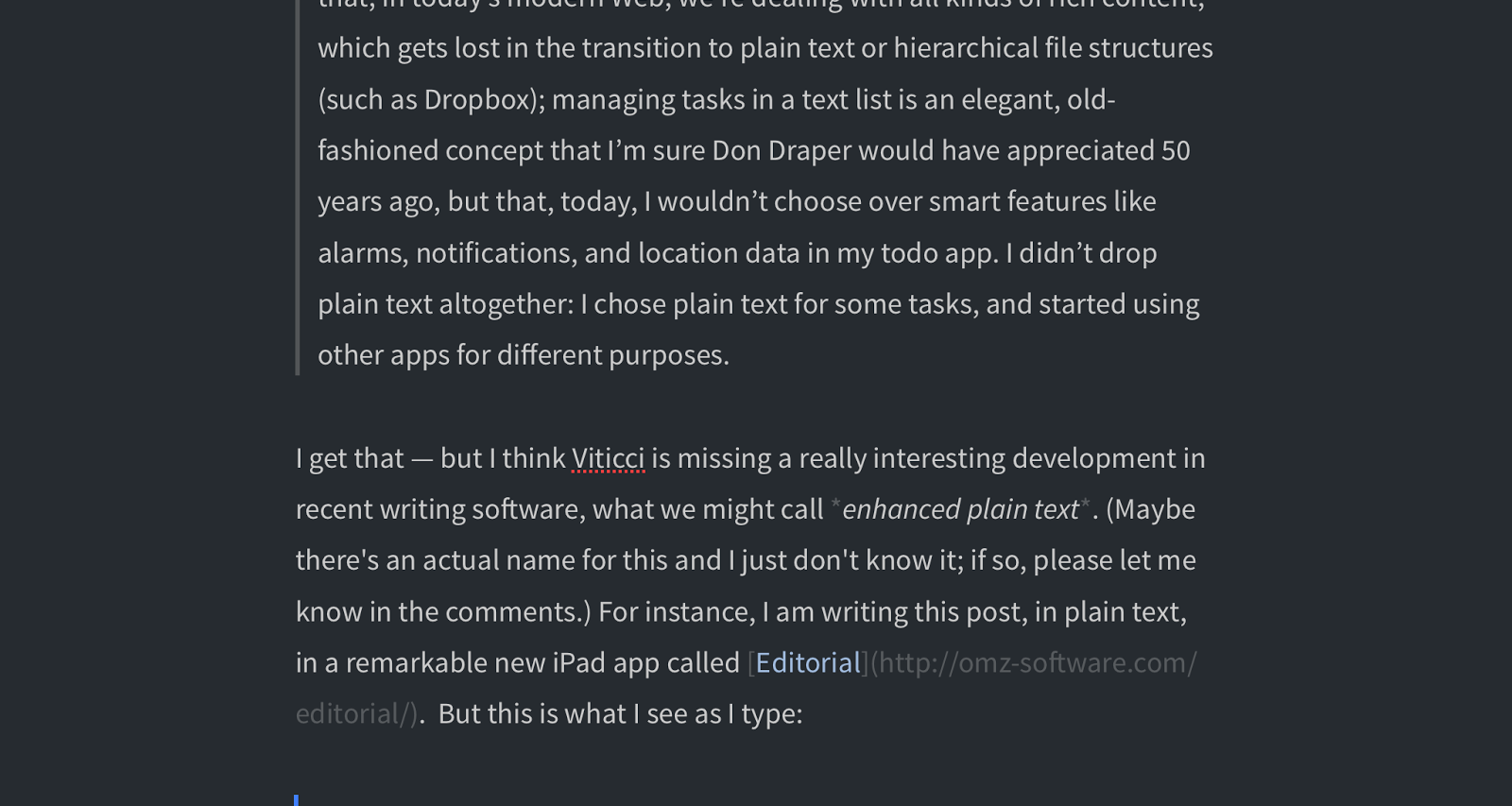
For some years now I have been a big believer in the Gospel of Plain Text: eschewing whenever possible word processors, and indeed anything in a proprietary file format that creates documents I might someday be unable to open — or could open only by paying a hefty upgrade feed to a software maker. Plain text files are very small and fully portable: they can be opened on any computer, and are as future-proof as anything in this vale of tears can be.
But still, I read with interest a recent post by Federico Viticci that points to the limits of a plain-text-only workflow:
I came to the conclusion that, in spite of the inner beauty of plain text, some things were better off as rich text or contained inside an app’s database. By saving links to interesting webpages as plain text URLs, I was losing the ability to easily tap on them and open them in a browser; by organizing tasks in a plain text list, I started feeling like a GTD hippie, presumptuously denying the higher appeal of tools like OmniFocus and Reminders. Plain text is great…until it’s not. It’s silly to deny the fact that, in today’s modern Web, we’re dealing with all kinds of rich content, which gets lost in the transition to plain text or hierarchical file structures (such as Dropbox); managing tasks in a text list is an elegant, old-fashioned concept that I’m sure Don Draper would have appreciated 50 years ago, but that, today, I wouldn’t choose over smart features like alarms, notifications, and location data in my todo app. I didn’t drop plain text altogether: I chose plain text for some tasks, and started using other apps for different purposes.
I get that — but I think Viticci is neglecting a really interesting development in recent writing software, what we might call enhanced plain text. (Maybe there’s an actual name for this and I just don’t know it; if so, please let me know in the comments.) For instance, I am writing this post, in plain text, in a remarkable new iPad app called Editorial. But this is what I see as I type:
In Editorial, I create plain text files but, instead of a .txt file extension, I label it as .md, for Markdown, John Gruber’s simple markup syntax. Editorial then provides appropriate syntax highlighting, as you can see from the image, and when I’m ready it will, with a single click, convert this document to nicely formatted HTML, ready for posting.
But, as when you view an HTML file in your browser (HTML files also being plain text), what changes here is merely the presentation, not the text itself. If I ever find myself trying to open this file in a text editor that doesn’t recognize the .md extension, I just have to change it to .txt and my file will be perfectly readable. So an app like Editorial gives me the simplicity and portability of plain text with structural markup that makes that text easier for me to read and use.
Similarly, when I’m on my Mac I take all my notes in an app called nvALT, in which I use plain text files only — but the app recognizes links I paste or type in and makes them clickable, and in one note I can link to another one simply by placing its title in [[double brackets, like this]] — and now that title becomes clickable: a click takes me to that note. This, along with the use of tags, enables me to keep all my research for the book I’m working on highly organized and easily accessible — a major boon for me.
Or consider TaskPaper, an app that’s far too little-known: it’s a simple but very useful task manager, which can also serve as an outliner. In TaskPaper I can keep track of projects, tasks, and sub-tasks in a hierarchical list with clickable tags; and I can create a color scheme that keeps all these elements visually distinct from one another. And yet .taskpaper files are just text files: as with .md files, I can just change the extension to .txt with no loss of data.
And then there’s LaTeX, about which I can geek out so enthusiastically that I probably shouldn’t even allow myself to get started….
Anyway, I love apps that do this: that give the structural and visual appeal we typically associate with complicated and proprietary file formats while retaining the underlying simplicity and universality of plain text. So while there may be good reasons for going beyond plain text at times, those times don’t come around as frequently as many people think. I’m gonna keep preaching that Gospel.



Hmmm — I think I may have inadvertently deleted a paragraph when I was getting this ready to post. I meant to note that I'm quoting Viticci from a celebratory review of Editorial, so he obviously can recognize the value of enhanced plain text. I just think it has even more value than he does, and in different kinds of apps.
Amen and amen.
The proliferation of plain text applications like Editorial means that you can use plain text without resorting to the terminal. But if one doesn't mind the terminal, then Pandoc can do amazing things with plain text.